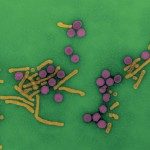Lien vers Pubmed [PMID] – 24646941
PLoS ONE 2014;9(3):e92140
Hepatitis C virus (HCV) establishes infection using host lipid metabolism pathways that are thus considered potential targets for indirect anti-HCV strategies. HCV enters the cell via clathrin-dependent endocytosis, interacting with several receptors, and virus-cell fusion, which depends on acidic pH and the integrity of cholesterol-rich domains of the hepatocyte membrane. The ATP-binding Cassette Transporter A1 (ABCA1) mediates cholesterol efflux from hepatocytes to extracellular Apolipoprotein A1 and moves cholesterol within cell membranes. Furthermore, it generates high-density lipoprotein (HDL) particles. HDL protects against arteriosclerosis and cardiovascular disease. We show that the up-regulation of ABCA1 gene expression and its cholesterol efflux function in Huh7.5 hepatoma cells, using the liver X receptor (LXR) agonist GW3965, impairs HCV infection and decreases levels of virus produced. ABCA1-stimulation inhibited HCV cell entry, acting on virus-host cell fusion, but had no impact on virus attachment, replication, or assembly/secretion. It did not affect infectivity or properties of virus particles produced. Silencing of the ABCA1 gene and reduction of the specific cholesterol efflux function counteracted the inhibitory effect of the GW3965 on HCV infection, providing evidence for a key role of ABCA1 in this process. Impaired virus-cell entry correlated with the reorganisation of cholesterol-rich membrane microdomains (lipid rafts). The inhibitory effect could be reversed by an exogenous cholesterol supply, indicating that restriction of HCV infection was induced by changes of cholesterol content/distribution in membrane regions essential for virus-cell fusion. Stimulation of ABCA1 expression by GW3965 inhibited HCV infection of both human primary hepatocytes and isolated human liver slices. This study reveals that pharmacological stimulation of the ABCA1-dependent cholesterol efflux pathway disrupts membrane cholesterol homeostasis, leading to the inhibition of virus-cell fusion and thus HCV cell entry. Therefore besides other beneficial roles, ABCA1 might represent a potential target for HCV therapy.

